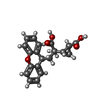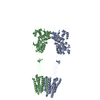+Search query
-Structure paper
| Title | Structural basis of positive allosteric modulation of metabotropic glutamate receptor activation and internalization. |
|---|---|
| Journal, issue, pages | Nat Commun, Vol. 15, Issue 1, Page 6498, Year 2024 |
| Publish date | Aug 1, 2024 |
 Authors Authors | Alexa Strauss / Alberto J Gonzalez-Hernandez / Joon Lee / Nohely Abreu / Purushotham Selvakumar / Leslie Salas-Estrada / Melanie Kristt / Anisul Arefin / Kevin Huynh / Dagan C Marx / Kristen Gilliland / Bruce J Melancon / Marta Filizola / Joel Meyerson / Joshua Levitz /  |
| PubMed Abstract | The metabotropic glutamate receptors (mGluRs) are neuromodulatory family C G protein coupled receptors which assemble as dimers and allosterically couple extracellular ligand binding domains (LBDs) ...The metabotropic glutamate receptors (mGluRs) are neuromodulatory family C G protein coupled receptors which assemble as dimers and allosterically couple extracellular ligand binding domains (LBDs) to transmembrane domains (TMDs) to drive intracellular signaling. Pharmacologically, mGluRs can be targeted at the LBDs by glutamate and synthetic orthosteric compounds or at the TMDs by allosteric modulators. Despite the potential of allosteric compounds as therapeutics, an understanding of the functional and structural basis of their effects is limited. Here we use multiple approaches to dissect the functional and structural effects of orthosteric versus allosteric ligands. We find, using electrophysiological and live cell imaging assays, that both agonists and positive allosteric modulators (PAMs) can drive activation and internalization of group II and III mGluRs. The effects of PAMs are pleiotropic, boosting the maximal response to orthosteric agonists and serving independently as internalization-biased agonists across mGluR subtypes. Motivated by this and intersubunit FRET analyses, we determine cryo-electron microscopy structures of mGluR3 in the presence of either an agonist or antagonist alone or in combination with a PAM. These structures reveal PAM-driven re-shaping of intra- and inter-subunit conformations and provide evidence for a rolling TMD dimer interface activation pathway that controls G protein and beta-arrestin coupling. |
 External links External links |  Nat Commun / Nat Commun /  PubMed:39090128 / PubMed:39090128 /  PubMed Central PubMed Central |
| Methods | EM (single particle) |
| Resolution | 3.4 - 3.8 Å |
| Structure data | EMDB-41578, PDB-8trd:  EMDB-45242: mGluR3 in the presence of the antagonist LY 341495 and positive allosteric modulator VU6023326 class 2 |
| Chemicals |  ChemComp-Z99: |
| Source |
|
 Keywords Keywords | MEMBRANE PROTEIN / GPCR / synaptic protein |
 Movie
Movie Controller
Controller Structure viewers
Structure viewers About Yorodumi Papers
About Yorodumi Papers






